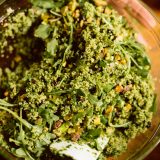Because for what essentially are just tiny dots of pasta, the start-to-finish process is arduous and makes little sense for today’s home cook. In fact, it took us days of digging through the history and science of this seemingly simple food to understand why it ever made sense.
We figured the appeal was easy transport. Couscous is light and durable, qualities you want when heading across the dunes. We had no idea that the intense process of making it—the first written record of which dates to the 13th century—also had impressive preservative benefits.
Couscous begins as hard durum wheat, which traditionally was pounded to break up the endosperm (starchy center), bran and germ. The resulting flour was mixed with water, then rolled by hand to form pellets. From there, the couscous was sieved, steamed and dried several times, all of which produced small grains that (mostly) resist clumping.
That’s an important difference from today’s couscous, which is made just from the endosperm, in the form of highly refined semolina flour. That refinement gives the flour—and any pasta product made from it—a long and stable shelf life. But the technology to isolate the endosperm from the bran and highly perishable germ is only a couple hundred years old.
Which is why couscous—despite the effort—made sense for North Africa. For hundreds of years it was, by definition, a whole grain. And whole grains need special care to keep from going rancid, particularly in hot, arid climates.
Those repeated cycles of steaming and drying? Turns out they inactivate the enzymes that otherwise oxidize the fat in the germ and cause it to spoil within months of being pounded. The rolling helped, too, coating the delicate germ with starch-rich endosperm that further protected it from oxidation.
Of course, not a lot of that matters now. Most couscous today is made from refined flour using machines that replicate hand rolling. But the ease of buying it in a box doesn’t change one of the most vexing characteristics of couscous—it can be pretty dull and uninspiring. After all, it is the North African version of potatoes or pasta, an ever-ready starch that really only shines when gussied up with something else.
A paste made from heaps of fresh herbs both flavors and hydrates the couscous.
Our early efforts to flavor couscous mostly fell flat. Once the couscous was cooked, it seemed unwilling to absorb flavors with the intensity we wanted. And that was our first clue to take a step back and reconsider how we were cooking it.
Traditional cooking methods call for a multistep rinsing, steaming and dousing process that can take close to an hour and a generous amount of water. The streamlined version—the one found on the back of the box—calls for soaking the couscous with an equal volume of water for about 5 minutes. We guessed correctly that the water was our problem.
We made a fresh batch using the back-of-the-box method, but reduced the water by 25 percent, essentially undercooking the couscous. It sounds wrong, but we found that leaving the grains a bit dry allows them to better absorb other flavors.
We knew we wanted to include currants in our final recipe—they offer a subtle sweetness and textural contrast—so we tried adding them as we doused the dry couscous with boiling water. Not only did this give the currants time to plump, it also further reduced the amount of water available to be absorbed by the couscous.
Of course, this meant whatever flavors we added would need to be moist (to hydrate the “thirsty” couscous). Our inspiration came from London chef Yotam Ottolenghi, who pairs couscous with dried apricots and a generous heap of fresh tarragon, mint and parsley.
We tend to think of fresh herbs as something used sparingly—a little thyme here, a shred or so of basil there. But here, the answer was to pile them on—4 cups of them, in fact—plus 2 cups of peppery arugula.
And to get the most flavor from the herbs—and help that flavor be absorbed—we turned them into an oil-based paste (punched up with a splash of brine from a jar of pickled jalapenos). Think pesto but more vibrant. Just a quick whir in the food processor transformed them into the perfect medium to finish hydrating the couscous. The result? Perfectly cooked, intensely flavored couscous. No desert adventure needed.




